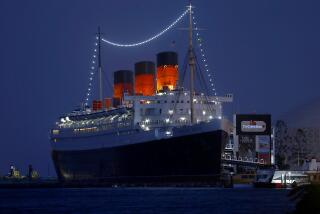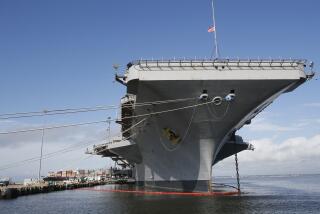One Last Battle Looming for Historic Warship
- Share via
QUINCY, Mass. — When commissioned in 1949, the U.S. heavy cruiser Salem was a state-of-the-art warship notable for its sleek design, rust-resistant nickel plating and, in a naval first, air conditioning.
President Harry S. Truman and Sir Winston Churchill were among dignitaries who boarded the Salem during its service as head of the U.S. fleet in the Mediterranean.
For the last 10 years, the Salem has served as a floating museum here -- attracting thousands of schoolchildren, war veterans and retired shipyard workers.
But the grounds of the former Fore River Shipyard -- where the Salem was built almost 60 years ago -- have been sold, and as the 718-foot ship faces possible eviction, its future is in question.
“The best thing is if they would say, ‘Look, this is a memorial ship with exhibits from all over the country, and we want to keep it here,’ ” said former Quincy Mayor James Sheets, chairman of the board of the U.S. Naval Shipbuilding Museum Corp. here. “The worst thing would be if we had to go through an eviction process, which I think would be difficult, maybe impossible.”
Founded in 1884 by an assistant to inventor Alexander Graham Bell, the Fore River Engine Co. switched to shipbuilding in the late 1890s, when the Navy commissioned the construction of two 400-ton destroyers. At its peak during World War II, the 130-acre facility employed 32,000 workers, making it one of the world’s busiest shipbuilding centers.
Ships built in Quincy during World War II carried a special stamp from the yard’s welding inspector, James J. Kilroy. The phrase “Kilroy was here” became a wartime chestnut.
Tankers, submarines, destroyers and freighters were among the vessels produced at the shipyard south of Boston. Of 572 ships built at Fore River, 29 remain in service.
Many of the ships built at Fore River were eventually used for Navy target practice and sunk. Others were sold to foreign countries or consigned to scrap. Four ships built at Quincy -- including the Salem -- are used as floating museums, and a fifth has been proposed for a site in Duluth, Minn.
The keel for the Salem was laid in 1943, but the ship was not completed and commissioned until 1949. David F. Winkler, a historian with the Naval Historical Foundation in Washington, called the ship, once considered the most modern gun-cruiser afloat anywhere, “a gorgeous warship.”
“As far as ship designs are concerned, that class of ships is one of the sleekest, nicest designs we have put out in the 20th century,” Winkler said.
Current cruisers, classed under the heading of Ticonderoga, “are very capable ships,” Winkler said. “But they look like shoeboxes.”
But as the Salem grew creaky, so did Quincy’s hopes of rebounding as a 21st century shipbuilding capital. The Fore River site was sold to the state water resources agency in 1987 for use as a staging area in the Boston Harbor cleanup effort.
In the mid-1990s, a Greek shipping tycoon announced plans to reopen the yard as a shipbuilding center. But Antonios Lelakis soon backed out. A second Greek shipbuilder subsequently abandoned another plan to revitalize the Quincy center.
In January, local car dealer Dan Quirk bought the grounds of the former Fore River Shipyard for $9 million at a foreclosure auction. Quirk’s plans to create a marine industrial park, as well as parking spaces for 2,500 cars, are on hold pending a challenge from another bidder.
Throughout the recent upheaval, the Salem has bobbed alongside the dock of a popular commuter ferry. Thousands of visitors -- many of them area schoolchildren -- annually walk the decks of the Salem, one of 29 memorial ships afloat in the U.S.
In recent years, the Salem has generated $450,000 to $500,000 in annual income -- almost exactly what it costs to keep her shipshape.
But overnight sleepover programs that helped support the Salem were stopped abruptly following a Rhode Island nightclub fire that killed 100 in February. Fire inspectors determined the ship had insufficient exits in the below-deck sleeping area.
Two years ago, supporters tried to move the Salem to another location in Quincy. But Marina Bay residents protested, and the plan was scrubbed.
As the Salem confronts the prospect of homelessness, naval historian Winkler noted that the vessel is significant not only to veterans who served on the ship or others like it but also to workers who labored in one of the country’s leading shipbuilding centers.
“These historic naval ships also serve as a wonderful educational tool for young American school kids,” Winkler said. “It gives a lot of people appreciation for what it was like to sleep on those things called racks, to use communal latrines, to go on the mess lines and to learn the ways of the sea. It also demonstrates what it was like to serve the country during a very important time period.”
Still, the Massachusetts Water Resources Authority has asked the Salem’s supporters to develop “an exit strategy.”
“Those people,” former Mayor Sheets said, “do not understand her intrinsic value for history and patriotism.”
More to Read
Sign up for The Wild
We’ll help you find the best places to hike, bike and run, as well as the perfect silent spots for meditation and yoga.
You may occasionally receive promotional content from the Los Angeles Times.






